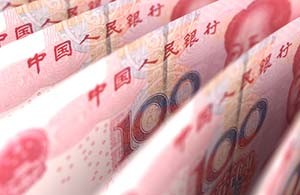 China's stock market rebounded 5.3% today (Thursday) following a Wall Street rally on Wednesday.
China's stock market rebounded 5.3% today (Thursday) following a Wall Street rally on Wednesday.
The Shanghai Composite Index soared 156.30 points today to finish the session at 3,083.59. It was the index's biggest one-day gain since June 30. The smaller Shenzhen Index added 59.14, or 3.33%, to close at 1,832.58.
Markets across the region also finished firmly in the green. Japan's Nikkei closed up 1.1% at 18,574.55. Hong Kong's Hang Seng ended higher by 3.6% at 21,838.54.
Key European markets were all higher by more than 2% in early afternoon trading Thursday.
U.S. stocks jumped higher after the opening bell too. The Dow, S&P 500, and Nasdaq were all up more than 1% just minutes after the open. The Dow, which had been in correction territory, trimmed its year-to-date loss to 7.5% Thursday morning.
Today's rebound followed a terrible week for China's stock market.
Wednesday marked the fifth straight day of declines for the Shanghai Composite. The benchmark fell below 3,000 for the first time in eight months on Tuesday to close at 2,964.97. In the five days from Aug. 19 through Aug. 26, the index shed 23.3%.
With the market collapsing, the Chinese government stepped in and attempted to prop up the markets...
Government Steps In as China's Stock Market Tumbles
In an attempt to calm markets, China's central bank cut its key lending rate by 0.25% to 4.6% Tuesday. The People's Bank of China (PBOC) also reduced banks' minimum reserve requirement by 0.5%, effective Sept. 6. The move will add roughly 678 billion yuan (about $105.7 billion) into the Chinese economy.
And that's not the only move...
On Wednesday, the PBOC also said it would inject $21.8 billion into the financial system.
Still, investors are watching to see if Beijing can help pull the world's second-largest economy out of its current slowdown. Panic about the volatility of China's stock markets has cut trillions of dollars from exchanges around the globe.
China is an important player in global trade. The Asian nation accounts for some 15% of global output.
China's economy grew at a robust 10% or more annually for much of the last 25 years. Since the 2008 global financial crisis, however, it has relied on what the International Monetary Fund (IMF) calls an "unstable growth model." Excessive loans and investments bought on margin have created huge risks in the country's banking, real estate, and corporate sectors.
Chinese leaders say they are intentionally moving toward a model of slower, more sustainable growth. The aim is for better-paying jobs in the service sector rather than low-wage factory jobs, more innovation, and a more vigorous consumer sector.
Growth, which slowed to 7.4% last year, is expected to contract further this year.
In July, the IMF pegged China's growth rate at 6.8%. That's short of China's target for 7%. Contracting growth all but ensure China's stock market will remain volatile this year.
Watch the video for an explanation of China's stock market crash, plus how investors can protect themselves – and even profit – from these events…
Stay informed on what's going on in the markets by following us on Twitter @moneymorning.
Protect Yourself from a Total Market Collapse: According to CIA Asymmetric Threat Advisor Jim Rickards, there are five "flashpoints" that signal the death of the U.S. dollar and a complete economic collapse in the United States. Here's how you can protect yourself, and your money, before it's too late...
Related Articles:
- Bloomberg: Asian Markets
- The Wall Street Journal: India Stands to Benefit From China Slowdown, Global Reaction
- Business Insider: Chinese Stock Index Jumps 5.3% as Asian Stocks Rise


